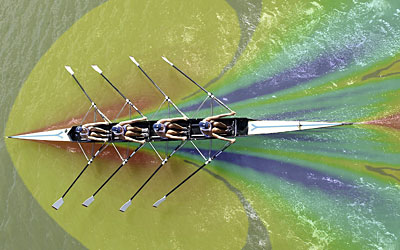
To become an Olympic Rowing champion you need two qualities in fair measure: grace and guts. More than any other sport, rowing combines sheer explosive power with fine technique. With winning margins measured in just tenths of a second, Gold medals are traditionally won by working harder and suffering more than your opponents. At this year's Olympics in Athens, however, those rules are about to change; blood, sweat and tears alone might not be good enough. For the first time the best teams will have a new tool in their shed. In Athens, Computational Fluid Dynamics (CFD) could be the difference between Gold and Bronze.
CFD is already widely used as an engineering tool within the maritime industry. Long used for optimizing hull designs under steady cruising conditions, it is also becoming increasingly important for predicting the complex three-dimensional phenomena applicable to maneuvering conditions. Used effectively it reduces the reliance on expensive towing tank tests and allows the investigation of a wider variety of more radical designs than would otherwise be possible.
Simulating a rowing boat, however, presents an even more complex challenge. While most boats are propelled at a constant rate, a rowing boat moves forward under the rhythmic rowing action of the crew. As the boat accelerates and decelerates through each successive stroke, both the position of the boat and its attitude in the water are dynamically modified, making this a complex problem with multiple-degrees of freedom.
At the forefront of the pioneering work in this field is Filippi Boats and partners. As a leading manufacturer of high quality, race standard, rowing boats, they have been using CD adapco's CFD code Comet for the past year to optimize their high tech designs for the upcoming Summer Olympics. Working together with a prestigious Italian university - Politecnico di Milano-MOX, their aim is to provide enough advantage to propel their oarsmen to the top of the Olympic podium.
Using Comet they have, for the first time, been able to simulate the influence of moving rowers on the boat and the periodic accelerations caused by each stroke of the oars and thereby the time dependant changes of resistance and propulsion. The simulation takes full account of both squat (also known as dynamic sinkage), the tendency of a moving boat to rise out of the water, and trim, its tendency to pitch in the water. Through these simulations, both squat and trim were shown to have major effects on resistance experienced by the boat.
The wrong amount of trim or squat in adverse conditions may allow water to flow over the side of the boat with immediate and devastating consequence. This point was all too clearly illustrated at the trial regatta for the Olympic Rowing Lake, which had to be abandoned after many of the boats sunk in choppy conditions. In rowing, taking on fluids is a real risk.
Due to their leading edge performance requirements, sports applications are an important benchmark for CFD applications. The application by Filippi Boats is a key example of the current trend in the marine world of how CFD software and services can perform multi-fluid six degree of freedom simulations.